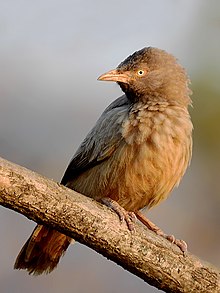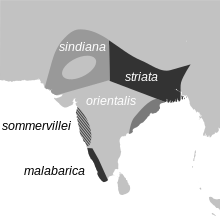Jungle babbler
| Jungle Babbler | |
|---|---|

| |
| Turdoides striata somervillei from Maharashtra | |
| Scientific classification | |
| Domain: | Eukaryota |
| Kingdom: | Animalia |
| Phylum: | Chordata |
| Class: | Aves |
| Order: | Passeriformes |
| Family: | Leiothrichidae |
| Genus: | Argya |
| Species: | A. striata
|
| Binomial name | |
| Argya striata (Dumont, 1823)
| |

| |
| Synonyms | |
|
Turdoides striatus | |
The jungle babbler (Argya striata) is a member of the family Leiothrichidae found in the Indian subcontinent. Jungle babblers are gregarious birds that forage in small groups of six to ten birds, a habit that has given them the popular name of "Seven Sisters" in urban Northern India, and (seven brothers) in Bengali, with cognates in other regional languages which also mean "seven brothers".[2]
The jungle babbler is a common resident breeding bird in most parts of the Indian subcontinent and is often seen in gardens within large cities as well as in forested areas. In the past, the orange-billed babbler, Turdoides rufescens, of Sri Lanka was considered to be a subspecies of jungle babbler, but has now been elevated to a species.
Taxonomy[edit]
The jungle babbler was described by the French zoologist Charles Dumont de Sainte Croix in 1823, based on specimens from Bengal. He coined the binomial name Cossyphus striatus.[3] This babbler was formerly placed in the genus Turdoides but following the publication of a comprehensive molecular phylogenetic study in 2018, it was moved to the resurrected genus Argya.[4][5]
There are several named geographically isolated subspecies that show plumage shade differences.[6] Former race rufescens of Sri Lanka is considered a full species. The widely accepted subspecies include:
- A. s. striata (Dumont de Sainte Croix, 1823) which is found over much of northern India south of the Himalayan foothills extending to Himachal Pradesh, Uttar Pradesh, Bhutan, Assam, Odisha and northeastern Andhra Pradesh. The form found in parts of Odisha, orissae, is said to be more rufous above and is usually subsumed into this.[7]
- A. s. sindiana (Ticehurst, 1920) is a paler desert form that is found in the Indus River plains of Pakistan and extends into Rajasthan and the Rann of Kutch in India.
- A. s. somervillei (Sykes, 1832) is found in the northern Western Ghats.
- A. s. malabarica (Jerdon, 1845) is found in the southern Western Ghats.
- A. s. orientalis (Jerdon, 1845) is found in peninsular India east of the Western Ghats.
Some older literature can be confusing due to some incorrect usage, such as with Whistler (1944, Spolia Zeylanica, 23:131), who used the name affinis which is a completely different species, Turdoides affinis, restricted to peninsular India. Although the two can sometimes be confused in poor lighting conditions, their calls are entirely different.[8][6]
Description[edit]

The jungle babbler's habitat is forest and cultivation. This species, like most babblers, is non-migratory, and has short rounded wings and a weak flight. The sexes are identical, drably coloured in brownish grey with a yellow-bill making them confusable only with the endemic yellow-billed babblers of peninsular India and Sri Lanka. The upper parts are usually slightly darker in shade and there is some mottling on the throat and breast. The race T. s. somervillei of Maharashtra has a very rufous tail and dark primary flight feathers. The jungle babbler can be separated from the white-headed babbler by the dark loreal zone between the bill and the eye as well as the lack of a contrasting light crown. The calls of the two species are however distinct and unmistakable. The jungle babbler has harsh nasal calls while the white-headed babbler has high pitched calls. Another babbler that is similarly found in urban areas is the large grey babbler; however, that species has a distinctive long tail with white outer tail feathers.[8]
The jungle babbler lives in flocks of seven to ten or more. It is a noisy bird, and the presence of a flock may generally be known at some distance by the harsh mewing calls, continual chattering, squeaking and chirping produced by its members.
Behaviour and ecology[edit]

These birds are gregarious and very social. They sometimes form the core of a mixed-species foraging flock.[9] They feed mainly on insects, but also eat grains, nectar and berries.[10] The groups maintain territories and will defend them against neighbours, which are nevertheless sometimes tolerated.[11] For their size, they are long lived and have been noted to live as long as 16.5 years in captivity.[12]
When foraging, some birds take up a high vantage point and act as sentinels. They are known to gather and mob potential predators such as snakes.[13]
Young birds have a dark iris. Older birds have an iris of a pale creamy colour and it has been found that the iris has a dark epithelium, which becomes invisible when the muscle fibres develop in the iris and make the dark basal colours invisible and thus appear cream-coloured.[14]
They breed throughout the year, with peak breeding in northern India being noted between March–April and July–September. Birds reach sexual maturity after their third year.[15] The nest is built halfway up in a tree, concealed in dense masses of foliage. The normal clutch is three or four (but can be up to seven) deep greenish blue eggs. In northern India, birds breeding during July–September tend to be parasitized by the pied crested cuckoo and sometimes by the common hawk-cuckoo.[16] Helpers assist the parents in feeding the young. Post fledging survival is very high.[15]
Birds fledge and females tend to leave their natal group after about two years.[15] Birds within a group often indulge in allopreening, play chases and mock fights.[17] When threatened by predators, they have been said to sometimes feign death.[18]
In culture[edit]
These birds are very common near towns and cities particularly in northern India and are well known for their habit of moving in groups giving them the local name of "Sat Bhai" which means seven brethren but translated by the English in India to "Seven sisters".[19] Visitors to India were very likely to notice these vocal and active birds and Frank Finn notes an incident during the Colonial period in India:
Some years back, a new Viceroy was being shown the wonders of his temporary kingdom, and among these the Taj at Agra held, of course, an important place. Arrived before the glorious monument of Eastern love and pride, the artless Aide-de-Camp was mute; the gilded staff were still as Kipling says, in anxious expectation of the comment of His Excellency. But this, alas when it came was merely the remark: "What are those funny little birds?" The shock must have been the greater for the fact that the mean fowls thus honoured were it seems, of that singularly disreputable species which is commonly known in India as the "Seven Sisters" or "Seven Brothers," or by the Hindustani equivalent of sat-bhai.[20]
The Indian folklorist Saratcandra Mitra recorded a belief among the Lushai-Kuki people that during a solar eclipse, humans could transform into jungle babblers.[21]
Gallery[edit]
-
Jungle babbler in Chandigarh.
-
Jungle babbler about to take off.
-
Subspecies malabarica
-
A jungle babbler, Kolkata, West Bengal, India
-
Nominate race from Kolkata allopreening
References[edit]
- ^ BirdLife International (2012). "Turdoides striata". IUCN Red List of Threatened Species. 2012. Retrieved 26 November 2013.
- ^ Yule, Henry (1903). William Crooke (ed.). Hobson-Jobson : A glossary of colloquial Anglo-Indian words and phrases of kindred terms etymological, historical, geographical and discursive. London: J. Murray.
- ^ Dumont, Charles (1823). Cuvier, Frédéric (ed.). Dictionnaire des sciences naturelles (in French). Vol. 29. Strasbourg: F.G. Levrault. p. 268.
- ^ Cibois, A.; Gelang, M.; Alström, P.; Pasquet, E.; Fjeldså, J.; Ericson, P.G.P.; Olsson, U. (2018). "Comprehensive phylogeny of the laughingthrushes and allies (Aves, Leiothrichidae) and a proposal for a revised taxonomy". Zoologica Scripta. 47 (4): 428–440. doi:10.1111/zsc.12296. S2CID 51883434.
- ^ Gill, Frank; Donsker, David, eds. (2019). "Laughingthrushes and allies". World Bird List Version 9.1. International Ornithologists' Union. Retrieved 20 January 2019.
- ^ a b Ripley, S Dillon (1958). "Indian Birds. VII". Postilla. 35: 1–12.
- ^ Ripley, S. Dillon (1969). "The name of the Jungle Babbler Turdoides striatus (Aves) from Orissa". J. Bombay Nat. Hist. Soc. 66 (1): 167–168.
- ^ a b Ali, S; S D Ripley (1996). Handbook of the birds of India and Pakistan. Vol. 6 (2nd ed.). Oxford University Press. pp. 224–230.
- ^ Rasmussen, PC; JC Anderton (2005). Birds of South Asia: The Ripley Guide. Vol. 2. Smithsonian Institution & Lynx Edicions. pp. 445–446.
- ^ Narang, ML; Lamba, BS (1986). "Food habits of jungle babbler Turdoides striatus (Dumont) and its role in the ecosystem". Indian Journal of Ecology. 13 (1): 38–45.
- ^ Gaston, AJ (1978). "The Evolution of Group Territorial Behavior and Cooperative Breeding". The American Naturalist. 112 (988): 1091–1100. doi:10.1086/283348. S2CID 84022037.
- ^ Flower SS (1938). "Further notes on the duration of life in animals. IV. Birds". Proceedings of the Zoological Society of London, Series A. A108: 195–235. doi:10.1111/j.1469-7998.1938.tb07895.x.
- ^ Devasahayam, S; Devasahayam, Anita (1991). "Aggressive behaviour of Jungle Babblers Turdoides striatus (Dumont) towards a snake". J. Bombay Nat. Hist. Soc. 88 (2): 288.
- ^ Andrew MI; RM Naik (1965). "Structural basis of the change of eye colour of the Jungle Babbler, Turdoides striatus (Dumont), during post-embryonic development". Pavo. 3: 72–74.
- ^ a b c Gaston, AJ (1978). "Demography of the Jungle Babbler, Turdoides striatus". Journal of Animal Ecology. 47 (3): 845–870. doi:10.2307/3675. JSTOR 3675.
- ^ Gaston, A. J. (1976). "Brood parasitism by the Pied Crested Cuckoo Clamator jacobinus". Journal of Animal Ecology. 45 (2): 331–48. doi:10.2307/3878. JSTOR 3878.
- ^ Gaston, A. J. (1977). "Social behaviour within groups of jungle babblers Turdoides striatus". Animal Behaviour. 25 (828–848): 828–848. doi:10.1016/0003-3472(77)90036-7. S2CID 53146659.
- ^ Neelakantan, KK (1957). "Hypnotic behaviour of a White-headed Babbler (Turdoides striatus)". J. Bombay Nat. Hist. Soc. 54 (2): 460–461. (Note: the reference uses the binomial of the jungle babbler)
- ^ Whistler, Hugh (1949). Popular handbook of Indian birds (4th ed.). Gurney and Jackson, London. pp. 40–43.
- ^ Finn, Frank (1904). The Birds of Calcutta. Thacker, Spink and Co.
- ^ Mitra, S.C. (1928). "Studies in bird-myths, No XXIV-on a Lushai-Kuki aetiological myth about the Jungle babbler". Quarterly Journal of the Mythic Society. 19 (2): 150–151.
Further reading[edit]
- Andrews MI, Naik RM (1965). "Some observations on flocks of the Jungle Babbler Turdoides striatus (Dumont) during winter". Pavo. 3: 47–54.
- Naik RM, Andrews MI (1966). "Pterylosis, age determination and moult in the jungle babbler". Pavo. 4 (1–2): 48–57.
- Andrews MI, Naik RM (1966). "The body weight and the thyroid and gonadal cycles of the jungle babbler". Pavo. 4 (1&2): 48–57.
- Andrews MI, Naik RM (1972). "The biology of the jungle babbler". Pavo. 8 (1&2): 1–34.
- Rana BD (1972). "Some observations on food of the Jungle Babbler, Turdoides striatus, and the Common Babbler, Turdoides caudatus in the Rajasthan Desert, India". Pavo. 8 (1&2): 35–44.
- Rana DB (1985). "Abnormality in the testis of Streptopelia decaocto and Turdoides striatus in the Rajasthan desert". Pavo. 23 (1&2): 101–102.
- Suresh PK, Chaturvedi CM (1986). "Annual endocrine cycles in male babbler, Turdoides somerveillei". Pavo. 24 (1&2): 43–54.
- Parasharya BM (1986). "Early breeding date of Jungle Babbler in Gujarat". Pavo. 24 (1–2): 117–118.
- Inglis CM (1936). "The Bengal Jungle Babbler or "Seven Sisters," Turdoides terricolor terricolor (Hodgson)". J. Darjeeling Nat. Hist. Soc. 10 (4): 117–123.
- Ali S (1974). "Jungle Babblers at Pali Hills, Bandra, Bombay 400050". Newsletter for Birdwatchers. 14 (11): 5–6.
- Ray-Chaudhuri R., Sharma T., Ray-Chaudhuri S. P. (1969). "A comparative study of the chromosomes of birds". Chromosoma. 26 (2): 148–168. doi:10.1007/BF00326452. S2CID 33927856.
{{cite journal}}: CS1 maint: multiple names: authors list (link)
External links[edit]
- Jungle babbler videos, photos & sounds on the Internet Bird Collection.
- Photo of a leucistic individual






